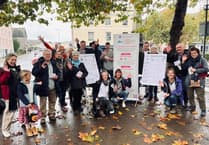The number of coronavirus cases has fallen again in the South Hams and by a third across Devon and Cornwall in the previous seven days for the second week in a row, official figures show.
A total of 1,547 new cases were confirmed in the last week as the total for the two counties now stands at 42,935 – the lowest total for seven weeks.
Devon also has the lowest infection rates of any upper tier authority in England, while of its eight districts, seven of them are in the bottom 10 of the 315 council areas, South Hams standing fifth.
Government statistics show that 1,547 new cases have been confirmed across the region in the past seven days in both pillar 1 data from tests carried out by the NHS and pillar 2 data from commercial partners, compared to 2,327 new cases confirmed last week.
Of the 1,547 cases confirmed since January 29, 592 were in Cornwall, with 108 in East Devon, 51 in Exeter, 105 in Mid Devon, 27 in North Devon, 242 in Plymouth, 55 in South Hams, 114 in Teignbridge, 203 in Torbay, 11 in Torridge and 39 in West Devon
This compared to 2,327 cases confirmed between January 23 and 29 of which 80 were in South Hams.
By specimen date though, not everywhere is seeing cases fall, with Mid Devon, Teignbridge and Torbay seeing case rate flat or slightly up.
A total of 1,152 of the cases in the past week have a specimen date between January 29 and February 4, with 36 in South Hams.
Torridge is the area in England with the lowest infection rate (35/100,000), with North Devon second (39/100,000), Exeter third (56/100,000), West Devon fourth (74/100,000), South Hams fifth (78/100,000), East Devon seventh (96/100,000), Teignbridge ninth (100/100,000) in the bottom ten.
At upper tier level, Devon has the lowest infection rate in England at 77/100,000, and is the lowest since December 8.
The latest positivity rates for tests carried out stand at 3.3 per cent in South Hams.
The number of patients in Devon’s hospitals following a positive Covid-19 test has fallen by nearly 20 per cent in the last week – as beds occupied remain the lowest in England.
As of Tuesday morning, there were 403 patients occupying beds across the county after a positive test, down on the 442 as of the previous Tuesday.
Patient numbers have fallen in Exeter, Plymouth and Torbay, and have remained unchanged in North Devon, while the Nightingale Hospital has seen a slight rise as it continues to take in patients from elsewhere in the country.
Devon’s figures are slightly inflated by the fact that they have been taking in patients from elsewhere in the country, including Somerset and Dorset, because in those regions, they are closer to capacity than Devon is.
In total, as of Tuesday, there were 58 patients at the Royal Devon and Exeter Hospital (down from 80 as of Jan 26), 57 at the Nightingale (up from 55), 35 at Torbay Hospital (down from 42), 92 in Derriford Hospital in Plymouth (down from 112), 8 at North Devon District Hospital (unchanged), and four in Devon Partnership NHS Trust units (up from 3) although not all patients are local given some have been transferred to the region from elsewhere.
The figure for the Royal Devon and Exeter Hospital of 58 patients is the lowest that they have been treating for nearly three months – when there were 55 patients on November 7.
But in Cornwall, the number of patients in hospital has risen slightly, up to 149 from the 143 as of last week.
And the number of patients in mechanical ventilation beds across the two counties is slightly up as well, with 20 in Derriford, 10 at the Royal Devon and Exeter, and seven in Torbay, up from 35 in total as of last Tuesday, while in Cornwall, the total has risen from 13 to 14.
The figures show the amount of patients in hospital following a positive COVID-19 test who are currently occupying a bed.
But not every patient would necessarily have been admitted to hospital due to COVID-19, with a number of patients either contracting the virus inside the hospital, or being admitted for unrelated reasons but subsequently testing positive asymptotically when given routine tests.
And as a percentage of total acute beds available, 2 per cent of beds in North Devon are occupied with Covid patients, 4 per cent in Torbay, 10 per cent in Plymouth, and 15 per cent in Exeter, all down on the figures as of last week, but Cornwall at 16 per cent is slightly up.
North Devon, Torbay and Plymouth have the lowest percentage occupancy rates anywhere in England, while at a partnership level, Devon is the lowest.
And based on patients, both covid and non-covid related, in adult critical care, as a share of total capacity last winter, every single hospital in Devon has a lower occupancy of capacity that last winter.
Figures from the Health Service Journal, whereby 100 per cent equals last winter’s capacity occupied, Derriford is at 90 per cent, Exeter at 92 per cent, North Devon at 75 per cent and Torbay at 70 per cent. Cornwall though is at 127 per cent.
In the last week, there have been 30 deaths in Devon and Cornwall hospitals of patients within 28 days of a positive Covid-19 test, with 10 at Derriford, 10 in Cornwall, five in Exeter, three in North Devon and two in Torbay. Last week saw 73 deaths for the same reporting period.
In terms of the latest MSOA cluster maps, that cover the period of specimen dates between January 26 and January 31, there are 38 areas of Devon and Cornwall with between 0-2 cases, up from 23 as of last Friday
The MSOA areas in each region with the highest number of cases are Bodmin East (43), Kilmington, Colyton and Uplyme (24), Central Exeter (8), Willand, Sampford Peverell & Halberton (18), South Molton (6), Plympton St Mary (24), Totnes Town (14), Newton Abbot, Town Centre (18), Ellacombe (27), Shebbear, Cookworthy & Broadheath (11) and Tavistock (12).
In terms of infection rates per age range, case rates are highest in the 20-39 age ranges across Devon and Cornwall, with the over 80s having the second highest infection rates. Plymouth, Cornwall, Torbay and Teignbridge still have the over 80s as the highest infection rates, with, East Devon, Mid Devon, South Hams, Torridge and West Devon in the 20-39s, and Exeter and North Devon in the 40-59s.
It comes as Steve Brown, director of public health Devon, said that while cases of COVID-19 are now falling in Devon, case numbers are still much higher than they were.
He said: “It looks like the current restrictions are having a positive impact and we are starting to see cases come down. But we’re still seeing cases spreading between work colleagues. It’s often not because of the work place practices themselves, it’s more a consequence of social interaction between colleagues while at work. And too often, it’s the virus spreading between colleagues who are car sharing.”
More than 200,000 people in Devon have had their first Covid-19 vaccine, the highest in the South West, latest NHS England figures show.
The statistics, which provide the position as of January 31, show that there have been 217,344 vaccinations in the county, with 204,815 of them being the first dose.
The figures for Devon, which will have risen in the most recent days, are the highest number of vaccinations for any of the regions within the South West, and they show that 20.5 per cent of the population had received their first jab. This is up on the 14.5 per cent as of January 24.
With the adult population of the Devon STP area being 999,049, the 204,815 who had received their first dose, means that as of Sunday, 20.5 per cent of Devon’s residents had received at least one dose of the vaccine. Those numbers will have risen since, and are up on the 145,148 as of the position on January 24.
The statistics show that as of Sunday, of the 79,525 over 80s within Devon, 72,831 had received their first vaccine – a total of 91.6 per cent, with 10,838 – 13.6 per cent – having also had the second dose.
While the 91.6 per cent figure is lower as a percentage of the total cohort than anywhere else in the South West, Devon’s population of over 80s is significantly higher than every other region – more than double in some instances
Of those aged 75-79, 39,993 people have received the first dose of the vaccine – 72.7 per cent of the cohort – while 12,708 of those aged 70-74, 16 per cent of the cohort – had as of Sunday had at least one dose.
And 79,283 under 70s, primarily those employed in health and social care settings, had received the first dose of the vaccination as of Sunday – 10 per cent of the total under 70s.
The COVID-19 cases are identified by taking specimens from people and sending these specimens to laboratories around the UK to be tested. If the test is positive, this is a referred to as a lab-confirmed case.
Confirmed positive cases are matched to ONS geographical area codes using the home postcode of the person tested.
Cases received from laboratories by 12.30am are included in the counts published that day. While there may have been new cases of coronavirus confirmed or people having tested positive, those test results either yet to reach PHE for adding to the dataset or were not received in time for the latest daily figures to be published.




